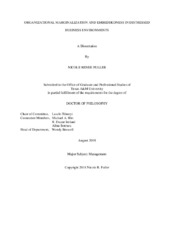| dc.description.abstract | Extant literature on institutionalization asserts that organizations establish norms and practices collectively with peer organizations to enhance stability in the business environment. Organizations with practices reflecting these expected norms attain legitimacy and strengthen their position in the environment. While research suggests that cooperative collaboration across organizational peers contributes to positive outcomes for the environment and its member organizations, the literature fails to identify the way in which institutionalization plays out in marginalized contexts. This research, therefore, extends existing work on institutional theory by exploring organizational behavior among isolated organizations, which challenges the inferred notion that all organizations identify with a network of peers. The study highlights organizations operating in underserved communities with limited resources. Accordingly, I assert that isolated organizations facing environmental constraints are less likely to mimic industry peers operating outside of their community, but instead engage in mimetic diversity. I further posit that marginalized organizations are less embedded in the region in which they operate, and instead place greater priority on the micro environment, or local neighborhood.
Through interviews with top managers of 10 organizations and surveys of top managers at 151 organizations operating in relatively high poverty neighborhoods in Houston, Texas, I find support that organizational marginalization is positively related to mimetic diversity, while mimetic diversity enhances an organization’s embeddedness within the local neighborhood. Contrary to the expectation that limited resources contribute to organizations’ engagement in mimetic diversity, the data indicate a positive relationship between access to resources and mimetic diversity. This study highlights an essential alternative to the classic behavioral constructs, institutional mimicry and strategic differentiation, by advancing the idea that forms of disadvantage preclude some organizations from pursuing either of these disparate lanes. This work offers implications for future research and practice. | en |


